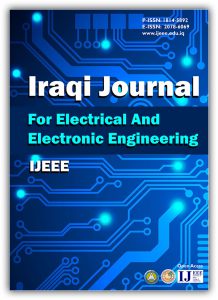
December 2017
<Previous Issue Next Issue>
| Traffic Offloading in LTE System Based Heterogeneous Networks |
| Mahmood F. Mosleh |
| Pages: 152-160 |
| DOI: 10.37917/ijeee.13.2.1 |
| FULL TEXT (PDF) |
| Abstract: |
|
The continuous growing developments in the traffic of mobile data limits the data throughput and capacity of cellular networks. “Heterogeneous Networks (HetNets)” are efficient solution to realize such demands. However, in HetNets, the congestion on the overloaded cellular network can be increased when the traffic of data is pushed from a cellular network to the Wi-Fi. In practice, offloading the cellular data traffic to a Wireless Local Area Network (WLAN) depending on the signal quality is a broadly deployed method to solve such problem. The use of Device to Device (D2D) communication further enhances the traffic offloading in WLAN systems and helps to obtain better throughput, end-to-end delay and network load. However, the critical offloading potential and its impacts on the whole performance is not totally understood. In this paper, the offloading of Long Term Evolution (LTE) traffic is presented using a WLAN for voice and video applications. A comparison is performed among two WLAN mechanisms; Distributed coordination function (DCF) and Point Coordination Function (PCF). As well, the effect of adding a D2D technology to the PCF is discussed. The WLAN effectively offloaded nodes at their Signal to Interference and Noise Ratio (SINR) becomes more than a specific threshold. Results presented that the PCF mechanism outperforms the DCF one in terms of packet loss ratio, throughput and the maximum load of the entire network. In addition, the use of a D2D serviced in the PCF helps in further reduction in the network load. |
| Determination of Residential Electrical Load Components In Iraqi North Region |
| Majid. S. Al-Hafidh, Mudhafar A. Al-Nama, Azher S. Al-Fahadi |
| Pages: 161-165 |
| DOI: 10.37917/ijeee.13.2.2 |
| FULL TEXT (PDF) |
| Abstract: |
|
The residential electrical load in the city of Mosul as well as in most of cities in Iraq, is the major problem for the administration of electricity distribution. Since this kind of load is increasing drastically compared with other loads such as industrial, agricultural tourism and others which are declining for the last two decades due to unstable condition of the county. |
| Estimation of analytical model for enhancement and implementation of an electro-optic switch |
| Sadeq Adnan Hbeeb |
| Pages: 166-172 |
| DOI: 10.37917/ijeee.13.2.3 |
| FULL TEXT (PDF) |
| Abstract: |
|
This research presents a technique of an electro optic effect for enhancement the an accomplishment of an electro optics switch using Mat lab simulation program . this technique includes design a mathematical model for evaluate the effect of different parameters such as refractive index (n), distance of separation between waveguides (d), length of electrodes (L), relative refractive index (Δn), and switching voltage (V), on the DC bias voltage of an electro optics switch. In this work the investigation of performance of an electro optics switch by analysis of an effect of distance between waveguides and the changing of refractive index on the bias voltage (V), and which optimizes when the wavelength is from 1300 into 1550 nm. Finally, an electro-optic active switch is designed and optimized, using the analytical model and which considers important device in the modern optical communication system. |
| Improve Linear Quadratic Regulator by Particle Swarm Optimization Algorithms for Two Wheeled Self Balancing Mobile robot |
| Ekhlas. H. Karam, Noor. M. Mjeed |
| Pages: 173-179 |
| DOI: 10.37917/ijeee.13.2.4 |
| FULL TEXT (PDF) |
| Abstract: |
|
The aim of this paper is to suggest a methodical smooth control method for improving the stability of two wheeled self-balancing robot under effect disturbance. To promote the stability of the robot, the design of linear quadratic regulator using particle swarm optimization (PSO) method and adaptive particle swarm optimization (APSO). The computation of optimal multivariable feedback control is traditionally by LQR approach by Riccati equation. Regrettably, the method as yet has a trial and error approach when selecting parameters, particularly tuning the Q and R elements of the weight matrices. Therefore, an intelligent numerical method to solve this problem is suggested by depending PSO and APSO algorithm. To appraise the effectiveness of the suggested method, The Simulation result displays that the numerical method makes the system stable and minimizes processing time. |
| A Biometric System for Iris Recognition Based on Fourier Descriptors and Principle Component Analysis |
| Muthana H. Hamd, Samah K. Ahmed |
| Pages: 180-187 |
| DOI: 10.37917/ijeee.13.2.5 |
| FULL TEXT (PDF) |
| Abstract: |
|
Iris pattern is one of the most important biological traits of humans. In last years, the iris pattern is used for human verification because of uniqueness of its texture. In this paper, biometric system based iris recognition is designed and implemented using two comparative approaches. The first approach is the Fourier descriptors, in this method the iris features have been extracted in frequency domain, where the low spectrums define the general description of iris pattern, while the high spectrums describes the fine detail. The second approach, the principle component analysis uses statistic technique to select the most important feature values by reducing its dimensionality. The biometric system is tested by applying one-to-one pattern matching procedure for 50 persons. The distance measurement method is applied for Manhattan, Euclidean, and Cosine classifiers for purpose of comparison. In all three classification methods, Fourier descriptors were always advanced principle component analysis in matching results. It satisfied 96%, 94%, and 86% correct matching against 94%, 92%, and 80% for principle component analysis using Manhattan, Euclidean, and Cosine classifiers respectively. |